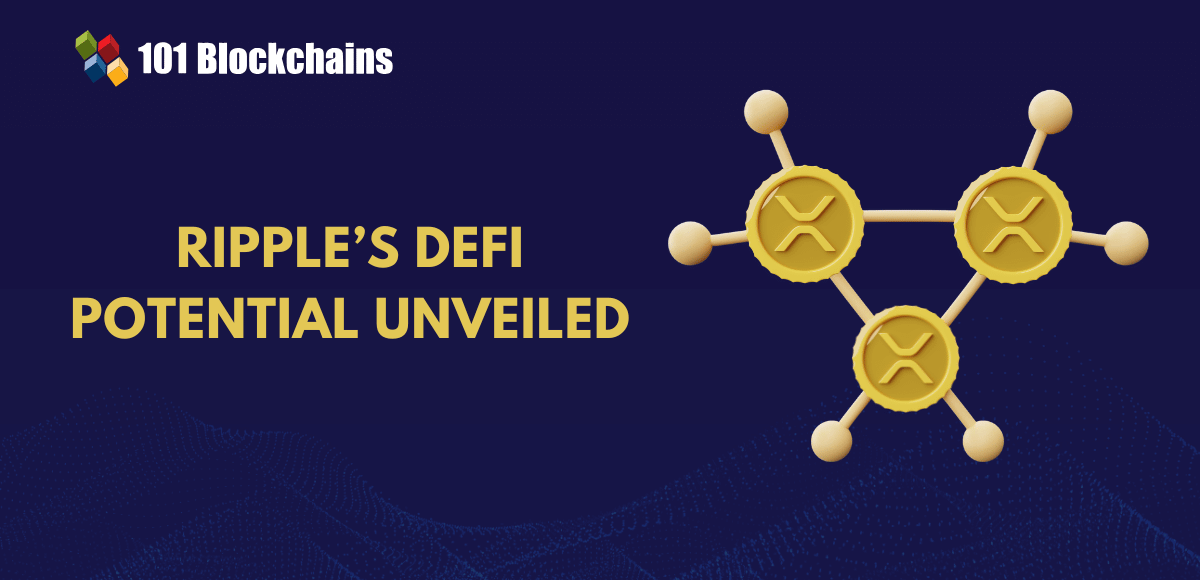Learn how blockchain truly works, master key definitions, and uncover what makes smart contracts so "smart." Dive into the fundamentals, gain valuable insights, and start your blockchain journey today!

- Decentralized Finance
Gwyneth Iredale
- on October 17, 2020
A Guide to Risks in DeFi and How to Manage them
No doubt, DeFi (Decentralized Finance) has been a buzzword in the current finance system but it has some risks associated with it. Let’s dive deep and understand different types of risks in DeFi and how to deal with them.
Centralized systems such as banks have been at the helm of the global financial industry for a long. However, the inequities in global financial systems in response to economic meltdowns have created formidable challenges for the fintech landscape. At this time, DeFi has emerged as one of the promising solutions for resolving issues about security and transparency of transactions and accessibility of financial services.
On the other hand, it is also important to understand the risks in DeFi to discover its potential from a neutral perspective. The knowledge of risks associated with DeFi can deliver a credible advantage in their efficient utilization for various goals in the fintech landscape. The following discussion provides you a detailed impression of potential risks related to DeFi that can help in better adoption of DeFi services.
Want to learn and understand the scope and purpose of DeFi? Enroll Now in Introduction to DeFi- Decentralized Finance Course
Different Types of Risks in DeFi
The three common types of risks of DeFi include financial risk, procedural risk, and technical risk. Financial risk relates to potential rewards of investment opportunities and management of the opportunities. Financial risk is commonly attributed to an organization or the risk tolerance of an individual. Financial risks also depend on the objectives of an individual for management of a successful investment portfolio.
Technical risk directly relates to hardware and software issues of DeFi products or services. The procedural risks relate to the users and the methods they follow for using DeFi products or services that can compromise security. Procedural risks are almost similar to technical risks with the difference in association with end-users.
Technical Risks
Technical risks in DeFi primarily arise from the issues with protocols, hardware, and software. The threat of technical risks is paramount as they can compromise the functionality of the complete platform. Technical risks can depend on various factors such as race conditions, API, use cases and exception handling, I/O handling, and memory safety. Race condition generally results in making the sequence responsible for the outcome of an event unreachable.
Memory safety risks point out the factors of memory interruptions, access errors, uninitialized variables, and memory risks. The lack of proper testing for use case and exception handling can interfere with user experience. Similarly, lack of proper testing and evaluation of APIs also hamper their functionalities. Technical risks due to I/O handling between devices result from lack of proper testing that renders inputs and outputs vulnerable.
Want to explore in-depth about DeFi protocol and its use cases? Enroll in Decentralized Finance (Defi) Course- Intermediate Level Now!
Smart Contract, Hardware, and Software Risks for DeFi
The risks in DeFi in the technical category also depend on smart contracts, software, and hardware. Smart contract risks for DeFi arise prominently because of the role of smart contracts in enabling automation. Smart contracts also present various vulnerabilities leading to technical risks for DeFi.
Smart contract risks include dependency on timestamp, front-running, inadequate gas griefing, integer underflow and overflow, and forcible transmission of ether to a contract. In front-running risk, hackers can leverage transactions mempool to take an unincluded block and make their desired modifications.
Integer overflow and underflow risks are evident in cases where the code cannot limit the value of unit variable to 2256. If it happens then, the value is automatically reset to zero. Timestamp dependence risk arises when miners aim at modification of timestamp of a block. In the forcible transmission of ether to a contract, the smart contract is vulnerable to self-destruction. Inadequate gas griefing risks related to smart contracts are reflective of initiating transactions without focusing on transaction sub call.
Hardware risks are also important technical risks in DeFi, especially with hardware serving as the foundation of infrastructure to run decentralized services. The common hardware risks related to DeFi systems include sensitivity, power issues, and incompatibility.
The power issues could result in consistency of the service or application, while voltage fluctuations pose risks to service life and performance. Sensitivity risks in hardware arise from degradation, humidity, dust, or other similar issues. Incompatibility risks hardware point out to hardware drivers that can restrict the speed of the system and cause additional issues.
Software risks are also one of the crucial technical risks when it comes to DeFi. The general risks for DeFi software include Distributed Denial of Service or DDoS attacks, injection, uncontrolled format strings, and overflow. DDoS is a credible mention among techniques for disruption of the normal functioning of an app or service.
Injection risks point out towards entry of malicious code into DeFi software with one of the popular injection risks in the form of SQL injection for web apps. Uncontrolled format strings depend on forms and can execute malicious code in a web app. Overflow risks in DeFi software are evident in skipping certain software functions or their execution in an undesirable manner.
Curious to understand the complete smart contract development lifecycle? Enroll in Smart Contracts Development Course Now!
Financial Risks Related to DeFi
The next important category of risks in DeFi draws attention to financial risks. The financial risks in DeFi provide insights on better use of DeFi platforms and services. For example, developers should focus on the right thing and reducing the financial risks for customers through the facility of correct advice and implementation of modifications in their DeFi application.
Financial risk points out to the risk of losing money, and every user is responsible for understanding financial risk through an impression of their appetite for reward and risk. On the other hand, an enterprise would focus on financial risk by balancing money management based on business operations.
Furthermore, in the case of governments, the financial risks depend on management and distribution of funds across various systems and solutions. The universal nature of DeFi makes it a suitable candidate for all the above areas while ensuring adequate value improvements. Therefore, it is reasonable to use tools such as technical analysis and fundamental analysis for better risk management in personal finance and traders and innovators in the DeFi landscape.
Fundamental analysis helps in evaluating the value proposition of various investments through different metrics and ratios. As a result, fundamental analysis reveals business value alongside the status of financial health. Technical analysis takes the fundamental analysis ahead using mathematical indicators, charts, and patterns to understand risks with a specific investment.
Build your identity as a certified blockchain expert with 101 Blockchains’ Blockchain Certifications designed to provide enhanced career prospects.
Procedural Risks in DeFi
The final entry among the risks points out to procedural risks. Interestingly, procedural risks primarily focus on the different security risks associated with DeFi products and services by users. The most common security risks in DeFi include phishing attacks in which a malicious agent duplicates a website or service to lure unsuspecting users into sharing their sensitive information.
Phishing attacks are also possible through emails in which users are sent an email mirroring that of service providers. As soon as the user clicks on the email, they are redirected to a malicious website. On the other hand, the phishing email can run malicious code in browser for adding keyloggers in the victim’s system.
The hacker could then leverage sensitive information for transferring funds or conduct illegal transactions without the knowledge of the user. Such phishing attacks are widely known across the cryptocurrency community, with hackers posing as representatives of a concerned DeFi service.
The understanding of procedural risks in DeFi should also accommodate other notable procedural hacks. The risks include baiting, pretexting, SIM-swapping, spearfishing, quid pro quo, and tailgating. Pretexting involves a hacker posing as a representative of a DeFi service and convincing users to share sensitive information. Baiting risks arise with ‘bait and switch’ methods for infection of a web page.
Spear phishing can present threats to the whole enterprise as it targets individuals in the organization for attacking the system. Spear phishing involves gaining system access to any person to control the core system functionalities and data. Quid Pro Quo risks are somewhat same as baiting; however, with the difference of hackers providing large incentives for motivating victims to work according to their wishes.
SIM-swapping is a dominant procedural risk found with DeFi, especially due to the use of personal information of users for creation of new SIM from concerned mobile service providers. Hackers can use the counterfeit SIM for committing illegal activities in the name of the user. Tailgating is one of the dominant risks in DeFi when it comes to accessing real-world locations by tricking a person in a superior position.
Want to explore an in-depth understanding of security threats in DeFi projects? Enroll in DeFi Security Fundamentals Course Now!
Best Practices to Deal with DeFi Risks
The detailed impression of the risks associated with DeFi point towards the need for security of digital assets. The recommendations and best practices to avoid the risks with DeFi can serve dominant benefits for security and protection. Let us take a look at the top pointers to deal with risks that are evident in DeFi landscape.
-
Choose Trustworthy Products and Services
The first and foremost recommendation to avoid risks in DeFi is the use of trusted products and services. Users should look for recommendations and reviews about a specific DeFi product or service before finalizing it. In event of any discrepancies in trust with a specific DeFi product or service, take a step back.
-
Leverage the Power of Multi-Factor Authentication
Multi-factor authentication is a formidable tool for ensuring security, especially with different credible verification methods. For example, email confirmation, two-factor authentication, or multi-signature authentication are some of the proven recommendations to avoid DeFi risks.
-
Never Show Your Digital Assets
Users should always refrain from showcasing details of their digital assets to ward off the attention of hackers on them. keep your digital assets confidential just as you keep other high-end personal data and you will be successful in avoiding the risks.
-
Security for Digital Assets
The security of digital assets can play a huge role in resolving threats of various risks in DeFi. Hot and cold storage are ideal choices for security of digital assets. Hot storage serves as an ideal wallet solution for actively accessing DeFi services. On the other hand, cold storage enables offline storage of digital assets to prevent the attention of malicious agents.
-
Importance of Updates and Backups
Backups and updates are also recommended best practices for keeping the risks related to DeFi to a minimum. Enterprises introduce new updates and patches in DeFi solutions for improving its security. Therefore, regular updates of DeFi software can take off the risks of new vulnerabilities. Furthermore, backups of digital assets on a different drive or in a diary can ensure higher availability of digital assets.
Catch up on the latest trends in decentralized finance (DeFi) and its connection to crypto with DeFi Skill Path
Bottom Line
On a final note, it is evident that understanding the DeFi risks clears the path for solving them. Any individual in the field of DeFi would be unreasonable in assuming that DeFi does not pose any risks. Accepting risks with DeFi paves the path for efficient adoption of DeFi products and services.
In the long run, DeFi would become a mainstream system for accessing financial services. So, personal investors, enterprises, and governments can learn more about efficiency of DeFi through an impression of associated risks. Start discovering more about DeFi with DeFi training course right now to foster its effective utilization.
*Disclaimer: The article should not be taken as, and is not intended to provide any investment advice. Claims made in this article do not constitute investment advice and should not be taken as such. 101 Blockchains shall not be responsible for any loss sustained by any person who relies on this article. Do your own research!



![30+ Best Decentralized Finance Applications [Updated] best decentralized finance (DeFi) applications](https://101blockchains.com/wp-content/uploads/2020/10/decentralized-finance-applications.png)

